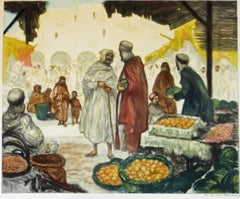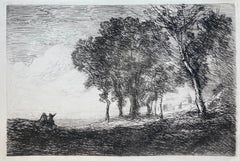WILLIAM ADOLPHE LAMBRECHT Landscape Prints
to
1
1
Overall Width
to
Overall Height
to
2
180
169
146
131
2
1
1
1
1
1
1
1
1
1
1
2
1
1
2
Artist: WILLIAM ADOLPHE LAMBRECHT
Hand colored Etching - Souk a’ Gabes Tunisia
By William Adolphe Lambrecht
Located in San Francisco, CA
This exceptional hand colored etching and aquatint is by the noted Parisian artist William Adolphe Lambrecht (1876-1940). The print depicts the Souk, or market in Gabes, Tunisia. It ...
Category
1920s Romantic WILLIAM ADOLPHE LAMBRECHT Landscape Prints
Materials
Etching, Aquatint
William Alphonse Lambrecht "Place Saint-Leger, Chambery, France" Etching c.1930
By William Adolphe Lambrecht
Located in San Francisco, CA
William Alphonse Lambrecht "Place Saint-Leger, Chambery, France" Original Etching C.1930
Plate dimensions 6.5" wide x 9.75" High
Frame dimensions 12.5" wide x 16.5" high
Pencil si...
Category
Early 20th Century WILLIAM ADOLPHE LAMBRECHT Landscape Prints
Materials
Etching
Related Items
French Etching - Place Stanislas
Located in Houston, TX
Playful black and white etching of a child figure looking out on a quaint city square in Nancy, France, 1959. Signed and dated lower right, titled and numbered 16 of 140 lower left. ...
Category
1950s WILLIAM ADOLPHE LAMBRECHT Landscape Prints
Materials
Paper, Ink, Etching
PAYSAGE D’ ITALIE
By Jean-Baptiste-Camille Corot
Located in Santa Monica, CA
JEAN-BAPTISTE CAMILLE COROT (1876 - 1875)
PAYSAGE D’ ITALIE 1866 (Melot 7 iii/iii)
Etching, plate 6 ¼ x 9 inches, Third state after the removal of the text but before the random scr...
Category
1860s Romantic WILLIAM ADOLPHE LAMBRECHT Landscape Prints
Materials
Etching
Fil du Temps
By Etel Adnan
Located in London, GB
Etel Adnan "Fil du Temps" 2021. Etching on wove paper. Edition of 100.
A critical work by Adnan, the final etching in this series. Etel was unable to put pencil to paper due to her ...
Category
2010s Abstract Impressionist WILLIAM ADOLPHE LAMBRECHT Landscape Prints
Materials
Etching
Rapunzel, Rapunzel, let down your hair David Hockney Brothers Grimm Fairy Tales
By David Hockney
Located in New York, NY
From David Hockney’s celebrated Six Fairy Tales from the Brothers Grimm portfolio, an image from the story of Rapunzel, which he chose for its popularity. When illustrating the princ...
Category
1960s Modern WILLIAM ADOLPHE LAMBRECHT Landscape Prints
Materials
Etching, Aquatint
"Green Farming" Japanese Landscape Woodblock Print
By Toshi Yoshida 1
Located in Austin, TX
Japanese woodblock print (etching) of a landscape by Toshi Yoshida
11" x 15" - Page Size
17 x 21.25 - Frame Size
Category
20th Century WILLIAM ADOLPHE LAMBRECHT Landscape Prints
Materials
Etching
Pavillon dans les Arbres (Pavilion in the Trees) /// Impressionist Henri Sidaner
By Henri Le Sidaner
Located in Saint Augustine, FL
Artist: Henri Le Sidaner (French, 1862-1939)
Title: "Pavillon dans les Arbres (Pavilion in the Trees)"
Portfolio: Henri Le Sidaner (Camille Mauclair)
*Issued unsigned, though signed by Sidaner in the plate (printed signature) lower left
Year: 1928
Medium: Original Etching on Rives BFK paper
Limited edition: Unknown
Printer: Unknown
Publisher: Galeries Georges Petit and Henri Floury, Paris, France
Reference: Bibliothèque Nationale No. 12
Sheet size: 11" x 8.38"
Image size: 9.25" x 7.13"
Condition: Some minor foxing on verso. It is otherwise a strong impression in excellent condition
Notes:
Printed in one color: bistre. Comes from Camille Mauclair's 1928 book publication "Henri Le Sidaner" which contained two bound original drypoint etchings by Sidaner. Comes with its original tissue cover...
Category
1920s Post-Impressionist WILLIAM ADOLPHE LAMBRECHT Landscape Prints
Materials
Drypoint, Etching, Intaglio
Venice Beach Seascape, Long Wave, Nautical Scene in Blue Tones, Limited Edition
By Kind of Cyan
Located in Barcelona, ES
This is an exclusive handprinted limited edition cyanotype.
This beautiful cyanotype is titled "Long Wave in Venice Beach" and it shows an outstanding wave in one of the most iconic ...
Category
2010s Realist WILLIAM ADOLPHE LAMBRECHT Landscape Prints
Materials
Paper, Emulsion, Watercolor, Engraving, Etching, Monotype
The glass mountain shattered David Hockney Fairy Tales from the Brothers Grimm
By David Hockney
Located in New York, NY
This etching from David Hockney’s celebrated Six Fairy Tales from the Brothers Grimm portfolio depicts the somewhat obscure story Old Rinkrank, which Hockney chose to illustrate beca...
Category
1960s Modern WILLIAM ADOLPHE LAMBRECHT Landscape Prints
Materials
Etching, Aquatint
Beach scene, Inner Tube: Eric Fischl Aquatint Etching of sunlit nude woman
By Eric Fischl
Located in New York, NY
A glowing lemon-yellow wash of color floods this erotic beach landscape with light. Hidden in the dappled shadow of a tree, a nude woman glances downward as she applies sunscreen. A ...
Category
1980s Neo-Expressionist WILLIAM ADOLPHE LAMBRECHT Landscape Prints
Materials
Etching, Aquatint
$2,100
H 35.5 in W 54 in
The Church Tower and the Clock by David Hockney Brothers Grimm Fairy Tales
By David Hockney
Located in New York, NY
From David Hockney’s celebrated Six Fairy Tales from the Brothers Grimm portfolio, an image from the story of ‘Fundevogel’. This etching is from the Brothers Grimm tale of ‘Fundevoge...
Category
1960s WILLIAM ADOLPHE LAMBRECHT Landscape Prints
Materials
Etching, Aquatint
The bell tower by David Hockney (Six Fairy Tales from the Brothers Grimm)
By David Hockney
Located in New York, NY
From David Hockney’s celebrated Six Fairy Tales from the Brothers Grimm portfolio, an image from the story of ‘The boy who left home to learn fear’. Hockney chose this story for its ...
Category
1960s WILLIAM ADOLPHE LAMBRECHT Landscape Prints
Materials
Etching, Aquatint
$1,500
H 17.75 in W 16 in
Hermes Oak, Windsor Park, late 18th century English sepia aquatint, 1799
Located in Melbourne, Victoria
'Hermes Oak, Windsor Park'
Aquatint published by Samuel Ireland. From his 'Picturesque Views on the River Thames'. Ireland was an author and engraver who p...
Category
Late 18th Century Naturalistic WILLIAM ADOLPHE LAMBRECHT Landscape Prints
Materials
Engraving, Etching, Aquatint
William Adolphe Lambrecht landscape prints for sale on 1stDibs.
Find a wide variety of authentic WILLIAM ADOLPHE LAMBRECHT landscape prints available for sale on 1stDibs. You can also browse by medium to find art by WILLIAM ADOLPHE LAMBRECHT in etching, aquatint and more. Not every interior allows for large WILLIAM ADOLPHE LAMBRECHT landscape prints, so small editions measuring 13 inches across are available. Customers who are interested in this artist might also find the work of and John Mix Stanley. WILLIAM ADOLPHE LAMBRECHT landscape prints prices can differ depending upon medium, time period and other attributes. On 1stDibs, the price for these items starts at $450 and tops out at $895, while the average work can sell for $673.
Questions About WILLIAM ADOLPHE LAMBRECHT Landscape Prints
- 1stDibs ExpertJanuary 19, 2025William-Adolphe Bouguereau is famous for his artwork. During the 19th century, he was a leading French academic painter and supporter of the Salon. He remains best known for the way he depicted women, both in classically inspired works like Nymphs and Satyr and The Birth of Venus and romantic portraits like The Bohemian and The Young Shepherdess. On 1stDibs, shop a selection of William-Adolphe Bouguereau art.


